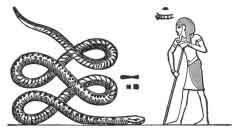Prev
Home Quiz
Shadowland: Redemption: Week 7
Exodus 7 starting with 6:28
http://biblehub.com/ezekiel/29-3.htm
http://biblehub.com/psalm/58-3.htm
- 6:28-7:5 A summary of the previous 6 chapters. Up to now, we
have had an inside look at Moses, and seen his insecurities,
and how God dealt with him. Now we focus on the results, where
onlookers saw a man confidently delivering God's message - backed
up with supernatural power.
- 7:7 Aaron was 3 years older than Moses. This tells us that the command
to expose male infants was given less than 3 years before Moses was
born.
- 7:9-10 "serpent" - תַּנִּין as in
Genesis 1:21.
 Everywhere else in the Bible, this word is translated "sea monster"
or "dragon". For this reason, J. Vernon McGee suggests that the rod
was actually transformed into a crocodile rather than a snake. The
translators chose "snake" because that is the word used in 7:15.
However, I have additional reasons to believe McGee is wrong.
Everywhere else in the Bible, this word is translated "sea monster"
or "dragon". For this reason, J. Vernon McGee suggests that the rod
was actually transformed into a crocodile rather than a snake. The
translators chose "snake" because that is the word used in 7:15.
However, I have additional reasons to believe McGee is wrong.
This miracle is the prelude to the plagues, and like the plagues
it is a direct attack on the gods of Egypt. Apep was the Egyptian
god of evil, chaos, and destruction. Every day, Apep attacks the
sun god Ra - occasionally succeeding in the form of a storm or even
an eclipse. Every day, he is slain - only to return to life the
next to renew his attack.
Every morning, the Egyptian faithful would gather at
the temple of Ra. The priests brought wax models of Apep and
performed an elaborate ceremony detailed in "Banishing of Apep"
with an accompanying liturgy of hymns and incantations.
- Spitting Upon Apep
- Defiling Apep with the Left Foot
- Taking a Lance to Smite Apep
- Fettering the god
- Taking a Knife to Smite Apep
- Putting Fire Upon Apep
Apep is usually depicted in Egyptian art as a serpent, but occasionally
as a crocodile. Verbal pictures of Apep describe him as a huge
serpent, several miles in length, living in the waters of Nun, the
celestial Nile. Definitely a sea monster.
While the Egyptians had obviously lost much of the knowledge of the
true God they had had just 450 years previous, notice the echoes
of Genesis 3:15 in the Banishing of Apep.
- 7:11 "the magicians of Egypt did the same" -
2 Timothy 3:8.
Pink is insistent that the Egyptian magicians duplicated the
miracle through demonic power. However, I am not so sure.
The ancient Egyptians practiced a form of snake charming, where
by pressing the nape of the neck, they throw them into a kind of
catalepsy rendering them stiff and immovable, resembling a rod.
When thrown down, the nerve block is released, restoring the snake
to motion. This trick is
still performed
today, and according the magician Walter Gibson in
Secrets of Magic the particular
species suitable for the stunt is the Egyptian Cobra.
- 7:12 Whether or not the magicians actually performed a miracle,
it is certain that Moses and Aaron did.
- 7:13 "Pharaoh's heart became hard". God hardened Pharoah's heart -
as 7:3 makes clear. Pharoah may have had a choice in chapter 5,
but now his course was set, and he will serve as an object lesson
to both Israel and the Egyptians.

- 7:15 "serpent" - נָחָשׁ as in
Genesis 3:1.
- 7:16-24 "changed into blood" - the text does not support literal blood,
as the Egyptians were able to filter the water through earth/sand.
Egyptian literature also refers to times when the "river is blood",
and the Egyptians knew just what to do when it happened in Exodus.
Furthermore, there is no mention of God "undoing" this plague as he did
others, which would certainly be needed for literal supernatural blood.
While a red silt would turn the water blood red, it wouldn't
necessarily kill the fish and frogs, thus a freshwater dinoflagellate
biomass bloom (toxic red algae) is usually cited as a likely material
cause, and similar blooms have affected a number of modern cities.
Whatever the nature of the "blood", it appeared when Aaron struck
the water, and thus was miraculous.
Hapi was the Egyptian god of the Nile. Hapi is described as partly male
and partly female with blue skin. Hapi brings the fertilizing rich black silt
on which Egypt depended for food to the banks of the Nile. (This could be
evidence that it was red silt rather than algae, as the plagues were
designed to target Egyptian gods.) The annual flooding of the Nile
was referred to as the "Arrival of Hapi" and was celebrated with great
festivals and river processions. Every year, Egyptian farmers would travel to
his shrines at Elephantine and Aswan to pray for an adequate flood and a fresh
supply of silt. Too little water would cause famine, and too much flood water
would be equally disastrous by limiting the sowing of fresh crops.
 Everywhere else in the Bible, this word is translated "sea monster"
or "dragon". For this reason, J. Vernon McGee suggests that the rod
was actually transformed into a crocodile rather than a snake. The
translators chose "snake" because that is the word used in 7:15.
However, I have additional reasons to believe McGee is wrong.
Everywhere else in the Bible, this word is translated "sea monster"
or "dragon". For this reason, J. Vernon McGee suggests that the rod
was actually transformed into a crocodile rather than a snake. The
translators chose "snake" because that is the word used in 7:15.
However, I have additional reasons to believe McGee is wrong.
